Sedum: description, varieties, planting and care

Sedum is a beautiful plant, very unpretentious in its content. Due to the lush flowering and the unusual shape of the leaf plates, it occupies a worthy place among the decorative species and is actively used in landscape design. The article will discuss the varieties of the flower, the intricacies of planting and care.

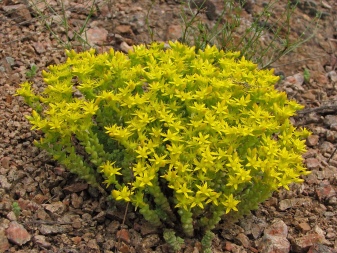


Peculiarities
Sedum, or sedum (from Lat. Sedum), is a member of the bastard family and belongs to succulents. The word "sedum" came into the Russian language from Ukrainian, in which it sounds like "cleansing" and means a means for cleansing wounds. Among the people, sedum is often called hare cabbage, squeaky and feverish grass. The scientific name - sedum - translated from Latin means "to pacify" (meaning the analgesic effect of the flower) or "sit", which is probably due to the fact that many varieties of the flower literally spread on the ground and rocks.




The sedum is a perennial, less often biennial, herbaceous, shrub or semi-shrub plant that grows on meadows and dry slopes of South and North America, Africa and Eurasia. The flower's trademark is its fleshy sessile leaves. They do not have petioles and are colored in gray, green, gray and even pink shades.
Moreover, the color of the leaves depends not only on the type of stonecrop, but also on the conditions of its growth. So, in plants living in the shade, the color of the leaves is not as saturated as in specimens growing in the sun. In addition, sometimes reddish streaks appear on the foliage, which is associated with the peculiarities of the composition of the soil and water.
The leaves of the sedum have an unusual shape and can be cylindrical, disc-shaped, ovoid and oval.



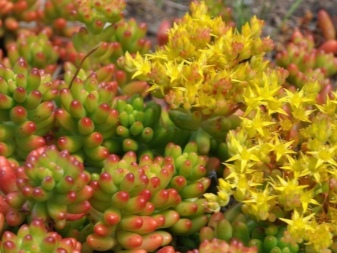
Stonecrop stalk is well branched, has a fleshy structure and is able to grow rapidly. Bisexual dense flowers form umbellate inflorescences and look very impressive. Most varieties begin to bloom in the second half of summer, and only a few of them bloom in autumn.
The yellow, red, white and pale blue flowers have slightly bent petals and, expanding, form a narrow tube with numerous stamens and ovary peeking out of it. The flowers exude a persistent pleasant aroma, which attracts many insects.

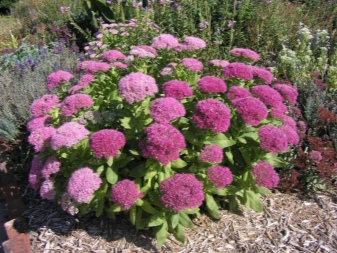
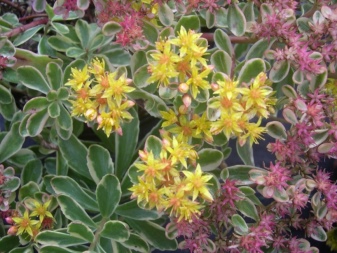

The description of sedum would be incomplete without mentioning the beneficial properties of the flower. Due to the high content of vitamins, tannins, alkaloids, coumarins, flavonoids, glycosides and saponins, the plant is widely used in folk medicine. Decoctions, infusions and extracts of sedum are used as anti-inflammatory, healing, laxatives, diuretics, analgesics and tonics and are used in the treatment of scurvy, burns, atherosclerosis, malaria, gout and nervous shocks.
Almost all varieties of flowers are used as a remedy, with the exception of caustic stonecrop. This species is allowed to be used with great care, however, due to its high toxicity, it is wiser to completely abandon it.
Contraindications to taking sedum-based funds are pregnancy, children under 18 years of age, hypertension and nervous irritability.


Types and varieties
The sedum genus has more than 500 species, most of which are not cultivated and grow in their natural environment. Below are several decorative varieties that are often used for landscaping and are grown as indoor flowers.
- Sedum large (from Lat. Maximum), also known as medicinal and common, is widespread in Europe, where it grows near pine forests and on riverbanks. The plant is distinguished by beautiful leaves densely adhering to the fleshy stem, painted in a rich green color. The species is more used as a street plant, since because of the poisonous sap, not all growers want to breed it.
However, some varieties are quite suitable for home cultivation and are very loved by flower growers. These include the variety "Matron", which grows up to 60 cm and is distinguished by beautiful blue-green leaves with a reddish bloom. During the flowering period, the bush is covered with light pink inflorescences and looks very elegant. The variety is no less popular. Linda Windsor, which is distinguished by strong burgundy stems, dark red leaves and hemispherical inflorescences with spectacular ruby flowers.



- Sedum of Morgan (from Latin Morganianum) belongs to the thermophilic species and grows in Mexico. In Russia, it is found only as an ampelous perennial indoor flower. The plant has red-brown tall stems (up to 100 cm) and cylindrical or oblong-elliptical light green leaves, which quickly fall off if handled carelessly. The species is characterized by dense, umbrella-shaped inflorescences of 10-15 pink-red buds and boasts abundant flowering.
The flower is quite poisonous, which is why it requires special care when growing. Among the most popular varieties are "Burrito" and Harry Butterfield... The first is distinguished by spherical leaves covered with a bluish waxy coating, has lodging stems up to 30 cm long and blooms from late spring to mid-summer.
The second is a hybrid of sedum and echeveria and is distinguished by unusual light green pointed leaves sticking out in different directions.



- Siebold's sedum (from lat. Sieboldii) grows in Japan on the island of Shikoku and is used as a greenhouse flower. Indoors, the species is grown as an ampelous perennial, placing it in hanging pots, baskets and pots. The plant is distinguished by reddish stems and gray-blue or blue-green foliage with jagged edges.
The species does not form fruit and blooms with bright pink flowers with a lilac tint with a dark crimson or cherry center. In winter, the plant loses its foliage, and with the arrival of spring, it quickly grows new. The most popular variety among florists is "Mediovariegatum" (from Lat. Mediovariegatum), which is distinguished by beautiful showy flowers and has a yellowish spot on each leaf, which turns red towards the end of the growing season.


- Stonecrop Kamchatka is represented by a perennial plant with a creeping rhizome, thanks to which the species multiplies quickly and covers the space provided to it with a beautiful dark green carpet. The species is characterized by showy yellow-orange flowers and oval leaves. Flowering begins in mid-June and lasts 3-4 weeks. The plant is actively used in folk medicine for the treatment of abscesses and tumors.
The species is widespread in the Far East, Kamchatka and Sakhalin, where it grows on hills and rocky mountain slopes. It has been cultivated as a decorative species since 1841.


- Sedum caustic differs in well-branched stems, not exceeding 10 cm in height, and oval leaves up to 6 mm long with small denticles at the edges. Peduncles have a shortened structure and consist of loose inflorescences of golden yellow color. One of the most popular varieties is "Yellow Queen" (from Latin Yellow Queen). The flower is characterized by small lime-lemon leaves and poisonous yellow inflorescences, consisting of small, star-like flowers. The variety is distinguished by abundant flowering, which occurs in mid-summer.
Fruits are formed in late August - early September and are represented by capsules with seeds.


- Sedum spanish (from Lat. Sedum hispanicum) grows up to 5-15 cm and can have pale green, light yellow, gray-pink or purple leaves, depending on the variety. Flowering begins in June and lasts about a month. With the deterioration of the conditions of detention, the species turns into an annual, but on fertile soils it grows very quickly and captures large areas.
The plant blooms with beautiful white or pink flowers, reproduces well by self-seeding. Among the popular varieties of the species can be noted "Purpureum" (from Lat.Purpureum) and "Aureum" (from Lat. Aureum).



- Rock sedum (from Lat. Sedum Rupestre) covers the ground with a continuous carpet up to 10 cm high, has blue-green leaves and bright yellow flowers. Flowering begins in June and lasts about 4 weeks. The plant does not tolerate excessive moisture, is quite winter-hardy, looks beautiful when landscaping roofs and walls, and is often used as a ground cover species. Among the popular varieties are "Angelina" (from Lat.Angelina) and "Monostrozum Kristatum" (from Lat. Monostrosum Cristatum).


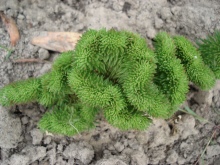
- Sedum six-row (from Lat. Sedum sexangulare L) is listed in the Red Book of the Leningrad Region as an endangered plant. The succulent has a branched rhizome, densely leafy branching stems and cylindrical fleshy leaves 36 mm long. The inflorescences are formed by 5-membered sessile flowers with a pale yellow corolla. The plant bears abundant fruit and multiplies easily with seeds. Flowering occurs in July.



- Sedum false (from Lat. Sedum spurium) is winter-hardy, has a creeping rhizome and stems branching from the base up to 20-25 cm long. The dark green fleshy leaves are opposite and grow up to 2.5 cm long and 1 cm wide. The variety is very popular among summer residents. "Pinky Winky", which is a bush up to 20 cm high with beautiful bright green foliage and pink flowers. The plant is drought-resistant and photophilous, with a lack of illumination, it stretches strongly and loses its attractiveness.
The variety is often used as a ground cover plant for garden plots.
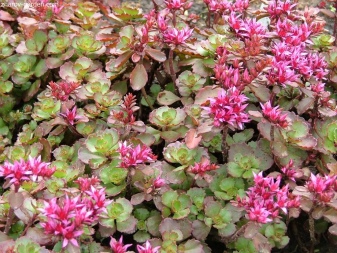



Selecting and preparing a landing site
Before planting sedum in open ground, you must choose the right site. The plant belongs to the category of light-loving and prefers sunny places with little natural shading during the daytime. If the culture is placed in the shade, it can lose the brightness of color and lose its decorative effect. You also need to pay attention to the soil. The best option would be loose and well-drained soils without liquid stagnation and with a significant proportion of river sand.
A distinctive feature of stonecrop is its amazing ability to grow on depleted soils and rocky soils. - that is, in the conditions in which it grows in the wild. However, if you add a little humus to the ground, then the sedum will show itself in all its glory and will surprise the owners with unusually lush flowering and juicy greenery.
Due to its undemanding soil composition and general endurance, sedum can grow in one place for up to 5 years.




How to plant in open ground?
Sedum is planted in open ground with seedlings, which are purchased in the store or grown independently. To do this, in early March, soil is poured into a small container, the seeds are laid out, a little sprinkled with a substrate and slightly moistened. Then they are covered with polyethylene, put into the vegetable tray of the refrigerator and kept for 2 weeks.
Next, the container is placed in a well-lit warm place, from time to time sprayed from a spray bottle, preventing the soil from drying out. Every day for 15-20 minutes the film is removed, allowing the planting to breathe.


After the first shoots appear, the film is removed. As soon as 2 leaves appear on young plants, they are dived into separate containers. Before disembarking on the street, the sprouts are regularly moistened and lightly loosened. A week before the transplant, sedum seedlings begin to harden. For this, containers with sprouts are taken out into the street and, starting from 20 minutes, the time of their stay in the open air is increased daily.


Around the second half of May, when the threat of night frosts has completely passed, the seedlings are transplanted into open ground. For this in the prepared area, pits are dug up to a depth of 20 cm and drainage from expanded clay, crushed stone or broken brick is laid on their bottom. A nutritious mixture made from sand, turf and humus, taken in equal shares, is poured on top, small depressions are made in the substrate and seedlings are planted.
The distance between adjacent holes should not be less than 20 cm, otherwise the plants will be too crowded. Then the plantings are watered with warm settled water and transferred to a general care regimen. Young stonecrops begin to bloom after 2-3 years.


How to take care of it properly?
The sedum is an undemanding plant and needs minimal maintenance, consisting of watering, feeding, pruning and preparing for the winter.
- Sedum does not like excessive moisture and requires moderate watering. Young, newly planted plants are watered a little more often, and mature bushes - only with prolonged drought. When watering domestic species, they are guided by the moisture content of the soil, preventing it from excessive drying out and cracking.
- Stonecrop should be fed a couple of times a year. - shortly before and after flowering, using liquid complex mineral fertilizers for succulents. Top dressing is applied only after watering, otherwise there is a risk of burning the plant roots. For soil cultivation of perennials, it is recommended to fertilize the soil with a solution of mullein diluted with water at a concentration of 1:10, or with a solution of bird droppings diluted at a ratio of 1:20. This must be done in the autumn, after the plant has faded. You cannot fertilize sedum with fresh manure.
- Sedum very quickly builds up green mass and requires regular pruning., during which old bare shoots, wilted inflorescences and too long stems of the bush are removed. Street perennials are pruned in the second half of autumn, cutting off shoots near the ground and leaving "hemp" no more than 4 cm in height.
- With the arrival of night frosts, the pruned bush is covered with mulching material in the form of straw, needles or spruce branches. In regions with cold, snowless winters, a covering non-woven material is laid on top of the mulch. In areas where there is a lot of snow in winter, the plant does not need additional shelter.




Growing a house in pots
The sedum plant can be grown not only in the open field - it has proven itself as a houseplant and grows well at home. It is only important to choose the right variety, as well as follow the rules of agricultural technology.
- For planting a flower you will need a shallow container with a perforated bottom, on which a layer of drainage from expanded clay or pebbles is laid. Soil mixture for sedum is purchased ready-made or made independently by mixing turf, peat and river sand in a ratio of 2: 1: 1.
- Nutrient substrate Pour into a pot and moisturize well. Then, rhizome-sized depressions are formed in it and seedlings are planted. After planting, the plant is slightly shaded and try not to disturb.
- After a week, the pot is moved to a sunny, draft-free place. In summer, the air temperature in the room where the flower is located should be +24 ... 28 ° С.The room is regularly ventilated, and on calm days they take out the flower to the balcony or garden.
- Watering is performed as the top layer of the earth dries up by 1-2 cm. Starting from mid-September, the intensity of watering is gradually reduced, and during the period of winter dormancy of the flower, which lasts from November to February, it is completely reduced to a minimum.
- For the winter, sedum is removed to a cool place with a temperature of +8 ... 12 ° С, since in warmer conditions it will continue to grow and will not rest. At the end of February, the flower is brought into the heat, gradually teaching watering. After full awakening, the plant is transferred to a general care regimen.
- The sedum is well tolerated by dry room air. and does not need additional spraying. This procedure is performed only to remove dust from the foliage and give the flower a fresh look.
- You can transplant a young sedum no more than once every 2 years. More mature bushes - every 3-4 years. In order to transplant the bush to a new place, the ground around it is well moistened, they wait for the water to be absorbed, and carefully dig out the rhizome together with an earthen lump. In this case, you should act very carefully, trying not to damage the leaves of the flower.



Reproduction methods
The sedum is propagated by seeds, cuttings, dividing the bush and layering. Each of the methods is quite effective and can be used based on personal preference.
- Seed method does not guarantee the preservation of all varietal characteristics of the mother individual, and therefore is not used too often. Before the onset of frost, seeds are collected from the sedum and placed on a clean sheet of paper to dry. A week later, they are poured into a paper bag and removed until February. It is recommended to store seed material at a temperature of + 18 ... 24 ° C. In the spring, the seeds are stratified in the refrigerator, after which they are planted in containers as described above.
- Cuttings is a very effective and convenient method of sedum propagation. A shoot of any size is cut from a strong adult bush and placed in the fresh air for several hours for weathering. Then it is planted in a container with a soil mixture prepared from garden soil and sand, and slightly moistened. When planting the cuttings, make sure that at least one nodule is buried in the ground. Rooting takes place quite quickly, and after a few weeks, the formed root system begins to grow. After a couple of young leaves appear, the plant can be dug out of the container and planted in a flower bed or in a pot.
- For dividing a bush large overgrown sedum is carefully dug out of the flower bed and freed from the ground. Then, with a sharp, disinfected knife, they divide it into the required number of parts, making sure that each of them has several sprouts and active kidneys. The cut sites are treated with fungicides, dried a little and the plant is planted in a permanent place.
- Stonecrop propagation with the help of layering allows you to get up to 10 new plants. To do this, the soil surface next to the bush is cleaned of weeds, moistened and slightly dug up. Then a lateral strong shoot is bent to the ground, fixed with garden pins and sprinkled with a nutrient substrate 1.5-2 cm thick. The cuttings are well moistened and left in the ground for germination.




Diseases and pests
The sedum is a strong and healthy plant. Problems arise very rarely and are associated with a violation of the growing rules for indoor breeding or with cold and rainy summers when growing in open field. With an excess of moisture, the risk of fungal diseases increases, which leads to the appearance of various kinds of rot on the ground and underground parts of the flower. Severely damaged specimens are dug out of the ground and destroyed, and newly diseased plants are treated with fungicides and watering is limited.
As for pests, they love the juicy greens of sedum and annoy the plant throughout the growing season. Aphids, false caterpillars, sawflies and weevils are especially often attacked. To combat the weevil, a white cloth is spread around the bush and at night, by the light of a lantern, insects are shaken off on it. Then the collected pests are destroyed, and the bush is treated with a decoction of hot pepper.


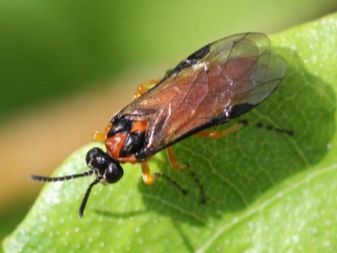

To combat other insects, insecticides or acaricides are used, such as Actellik and Fitoverm, or folk remedies are used. Good results are obtained by treating bushes with infusion of marigolds, onions, tansy, nettle, tobacco and dandelion, as well as dusting them with wood ash and spraying with rhubarb decoction, wormwood or soapy water.


Use in landscape design
The sedum plant looks beautiful in the garden. With its help, you can arrange quite large spaces, while spending a minimum of effort and money. The flower is highly valued by landscape designers who embody the wildest fantasies with it:
- a spectacular combination of stonecrop and hosts is an excellent solution for creating a border;

- a sedum flower garden will become a bright accent of the garden and will add variety to the simplest landscape;

- sedum as a ground cover plant gives the site an elegant and natural look;

- sedum looks great against the background of decorative greenery and deciduous trees;

- sedum in the composition of the flower arrangement looks very harmonious.

The video below will tell you about the varieties and intricacies of stonecrop care.






































































































The comment was sent successfully.